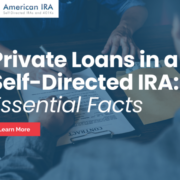Nine Types of Possible Investments in a Self-Directed IRA
One of the most appealing parts of turning to a Self-Directed IRA, for many investors, is the freedom it provides them. When self-directing, investors can turn to a broad range of asset classes: precious metals, real estate, and more. If you have followed this blog long enough, you have heard us tell you that time and time again. But what does “and more” really mean? Just what types of investments are possible with a Self-Directed IRA, and what do they look like? Let us explore.
Investment #1: Real Estate
It is not hard to describe what real estate is: buildings, land, or both. Many investors like real estate because it hedges against inflation—after all, people will always need houses, no matter what the economic climate. But the key here is to understand that real estate investors cannot use Self-Directed IRA real estate for their personal benefit, such as living it. It is investment real estate only.
Investment #2: Real Estate (Via Earnest Money Package)
An earnest money package can protect the seller if a buyer backs out, creating a sort of “earnest money” cushion that can be highly beneficial for people who are wary about transacting their retirement real estate. Yes, it is still the asset class of real estate, but we think it is worth mentioning here as another option in retirement investing.
Investment #3: Stock
Private stock, public stock—in short, you can buy stock in a Self-Directed IRA as you please. Private equity can be a powerful way to build up enormous sums within a retirement account, but only with a wisely placed investment. That is the part that is left up to you.
Investment #4: LLCs
People sometimes establish LLCs for sophisticated purposes, using the IRA to invest in the LLC, and then using that control over the LLC’s checkbook to make investments. It is a valid way to invest provided that it’s set up the right way—and therein lies the rub. You would have to work with a Self-Directed IRA administration firm with the right experience to help make the paperwork…work.
Investment #5: Unsecured Promissory Note
Think of a promissory note as a loan—the note is a promise from one part to another that one party will pay the other. An unsecured promissory note means that your IRA will not have security interest in collateral. On the other hand, there is…
Investment #6: Secured Promissory Note
This is a similar arrangement, except with “secured” debt, it is possible your IRA may have interest in underlying collateral. Remember: it is the IRA who serves as the lender in this case, not you.
Investment #7: Precious Metals
Specific kinds of gold and silver can make highly secure investments, especially when stored properly in an approved storage facility. However, these will not be household precious metals; you will have to keep them at a third-party site, arrange through your Self-Directed IRA custodian.
Investment #8: Land Trusts
Land trusts are organizations with authority over—you guessed it—land. They are “living trusts” according to Investopedia, which notes that “each land trust’s terms are unique and can be tailored to individual needs.”
Investment #9: Joint Ventures
Joint ventures can be powerful ways to save for retirement because they create additional supplies of capital for the investor. However, it is important to note that within an IRA, it is especially important to keep joint venture boundaries and personal boundaries very distinct.
Interested in learning more about Self-Directed IRAs? Contact American IRA, LLC at 866-7500-IRA (472) for a free consultation. Download our free guides or visit us online at www.AmericanIRA.com.







